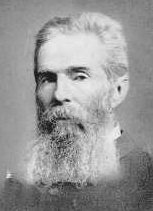Moby Dick, Herman Melville & “Strange, Sad” Lima

- “…like a Lima tower, cutting my boat in two”

Rereading yesterday’s post on writers and Lima’s weather, I became curious about Herman Melville’s riff on Lima as “the strangest, saddest city thou can’st see.”
When did Melville visit Lima? What prompted him to go into spasms of melancholy?
A quick Google search revealed that the quote doesn’t belong to Melville, per se, but rather to Ishmael, the narrator of Moby Dick.
The novel revolves around an embittered seaman, Captain Ahab, who is consumed with hunting down and killing the white albino whale who caused him to lose his leg.
In Chapter 42, “The Whiteness of the Whale,” Ishamel begins:
What the white whale was to Ahab, has been hinted; what, at times, he was to me, as yet remains unsaid.
That statement opens the door to a hallucinatory series of free-associations on “whiteness” and albinoism, and how that quality can inspire terror, especially if it’s a big white carnivorous whale you’re talking about.
In his metaphorical twistings and turnings, the narrator seizes on Lima as an example of a lifeless “white” city, one dominated by Pizarro’s legacy of white colonialism, with its racial and class divisions:
Nor is it, altogether, the remembrance of her cathedral-toppling earthquakes; nor the stampedoes of her frantic seas; nor the tearlessness of her skies that never rain; nor the sight of her wide field of leaning spires, wrenched cope-stones, and crosses all adroop (like canted yards of anchored fleets); and her suburban avenues of house-walls lying over upon each other, as a tossed pack of cards;- it is not these things alone which make tearless Lima, the strangest, saddest city thou can’st see.
For Lima has taken the white veil; and there is a higher horror in this whiteness of her woe. Old as Pizarro, this whiteness keeps her ruins for ever new; admits not the cheerful greenness of complete decay; spreads over her broken ramparts the rigid pallor of an apoplexy that fixes its own distortions.
The narrator is spot on when it comes to some of Lima’s low points: “cathedral-toppling” earthquakes, rough seas, and lack of rain (the “tearlessness of her skies”), natural phenomena that exist today.
The city’s architecture is what really gets his goat, however (it seems that the narrator visits Lima right after an earthquake has wrecked everything).
The narrator’s description of Lima in ruins is drawn from Melville’s own observations of the city in 1844, when he sailed to Peru as a crew member on the USS United States.
Literary scholars have been fascinated by Melville’s obsession with the city of Lima. The anthology Melville “Among the Nations” (edited by Sanford Marovitz and A.C. Christodoulou) includes a chapter by Wyn Kelly on Moby Dick and “The Style of Lima.”
Kelly’s chapter is worth a read, especially as it probes Melville’s hatred of the European conquest of Peru and how he invokes that disgust through descriptions of Lima’s Plaza de Armas.
Melville was deeply shaken by his visit to Lima in 1844, and in his imagination, the city’s Spanish-style architecture and its ruins expressed the “barbarism at the heart of urban civilization,” Kelly says.
I’d bet 100 soles Melville visited Lima during winter.




7 Comments
Fidel
Are you kidding? Nobody made a comment before? Well, I will. Thank you for this great posting. Lima la horrible sera nuestra novia por siempre. Cheers!
Barb
Fidel — Just checked out some of your blogs. Your photos are way cool, both the color and b&w work. I left two comments, to get the ball rolling. Very intriguing that you are intrigued by surrealism — El Fotografo is too. Maybe it’s something about growing up in Lima, all the odd juxtapositions.
Sebastián
Good to know!! I always thought it was due to the bleak weather… but I guess there was more to his words than just that. Thanks for the clarification!
Barb
You’re welcome, Sebastian (excuse the missing accent mark on the final “a” — I haven’t figured out how to add accent marks when writing in the comment box)
Hop Skip Jump Peru
I also went and checked out Fidel’s sight. I like it a lot. Do you ever have any exhibitions in Lima?
Hop Skip Jump Peru
sorry site, not sight – Duh!
erik hage
Yes, he did visit Lima (and Callao) in winter–early January 1844, to be exact.